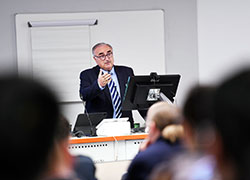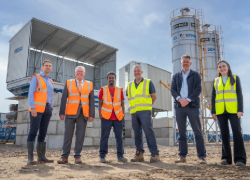Pioneering trees project takes root
A dream is turning to reality for a team of scientists who believe that trees could be the answer to one of industrial Teesside’s most difficult, and enduring, problems.
Ever since the area’s major industries started fading away, the area has been blighted by large swathes of brownfield sites, many of them polluted, all of them unsightly.
Now a pioneering project which could transform thousands of acres of derelict sites at very low cost and in an environmentally-friendly way, is expanding after successful trials.
The University of Teesside’s Clean Environment Management Centre (CLEMANCE) has, for a number of years, been using willow and grasses to clean up contaminated sites once used by industry, a process known as phytoremediation.
Called BioReGen, the project began in 2004 with test planting at several small brownfield sites, the first being a former enamel works at Fylands Bridge, near Bishop Auckland, County Durham.
It was a particularly difficult site for the team because it was blighted with pollutants stretching back many decades.
However, the willow trees and miscanthus, reed canary and switch grasses planted by the team cleaned up the soil by absorbing contaminants such as, zinc, copper, cadmium and heavy metals in coal ash.
Having seen the process work, BioReGen believes the method can work on bigger sites and planting has now started on five larger areas, each covering a hectare and all with a history of heavy industrial use.
The five full-scale demonstration sites being planted up are at:
- former Haverton Hill shipyard on the River Tees, near the Transporter Bridge, where Dr Lord and Janet Atkinson are pictured part of the old Head Wrightson engineering site
- at the Tees Barrage, made famous by Margaret Thatcher’s Walk in the Wilderness during a visit to Teesside two decades ago
- a former colliery and coal yard at Binchester, near Bishop Auckland, County Durham
- Warden Law, a landfill site and former gravel pit, near Sunderland
- a former sewage treatment works at Rainton Bridge, near Houghton-le-Spring on Wearside.
CLEMANCE believes the work, supported by a £1.2m grant from the European Union’s LIFE-Environment research programme, has major implications because it can be replicated wherever there are brownfield sites.
Dr Richard Lord, CLEMANCE’s Programme Leader for Contaminated Land and Water, said: ‘When we started this project, we did not know if we could grow plants on such contaminated land but it has been a success everywhere we have tried it. We have proved that phytoremediation works and what works on a small site can also do so on much larger sites as well.
‘It is also much cheaper than having to clean up a site or removing contaminated soils to landfill sites. The potential of our project is huge. There are 1,155 hectares of brownfield land in the Tees Valley alone.’
However, he is quick to point out that the technique is not rapid because it depends on Mother Nature to do her work at her own pace.
Dr Lord said: ‘This is not a quick fix. To get a site ready for development through this method could take years but we are on the right track. We regard it as a holding operation until the sites are needed for industry again.
‘In the meantime, we are making them attractive, and good wildlife habitats, rather than visions of unsightly dereliction which blight the image of the North-East. We are helping to create the Trees Valley.’
The sites were first treated with compost derived from recycled garden waste through the Waste and Resources Action Programme of ‘Trailblazer’ projects, part of a national scheme to demonstrate sustainable approaches to remediating brownfield land.
There may be other benefits beyond diverting waste from landfill. CLEMANCE has also been negotiating with energy provider SembCorp about providing willow to the company’s recently opened Wilton 10 wood-burning power station, on the Wilton International site near Redcar, east Cleveland.
Seen as a pioneering environmentally-friendly development, and expected to be the model for similar plants elsewhere in the UK, Wilton 10 needs large amounts of timber to continue generating power, and that could be of great interest to CLEMANCE.
Dr Lord said: ‘Wilton 10 has a huge appetite for timber and we can help provide it, particularly if we expand our planting over larger areas. What started as a research project has found a commercial application. This is as sustainable as it gets.’
For further information on any of these programmes, contact Dr Lord at CLEMANCE, School of Science & Technology, University of Teesside, Middlesbrough. Tel: 01642 384418, mobile: 07815 703567 or email: r.lord@tees.ac.uk
CLEMANCE is a research and enterprise unit in the University of Teesside’s School of Science & Technology and provides environmentally-sustainable solutions using innovative science and technology, supporting businesses in ways including the Contaminated Land and Water Programme. This helps landowners address the legacy of derelict brownfield land, contaminated soils and water.
Since 2003, CLEMANCE has pioneered the concept of Industrial Symbiosis in the Tees Valley, whereby waste products can be used as raw materials for other companies. It now hosts the National Industrial Symbiosis Programme in the region.
The Sustainable Technology Programme supports SMEs to identify carbon management options by determining their carbon footprint.
 Teesside University hosts groundbreaking hydrogen conference
Teesside University hosts groundbreaking hydrogen conference University supporting development of new £1m concrete plant
University supporting development of new £1m concrete plant Academic’s artwork on display at Middlesbrough station
Academic’s artwork on display at Middlesbrough station